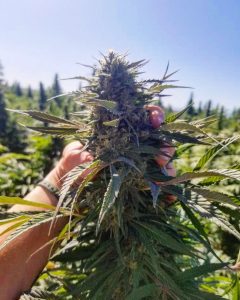When discussing sustainable cannabis, talk typically leans toward water conservation or energy efficiency. But, there are several overlooked areas of cannabis cultivation that are desperately in need of a sustainability overhaul.
Consider, for example, how much biomass is required to make cannabinoid isolates. Or, have you ever wondered how many outdoor plants are discarded every day due to mold, heat stroke, or wind damage?
Selective breeding could hold the key to addressing some of these issues and developing more resilient, vigorous varieties.
Environmental Considerations
CEO of Trilogene Seeds Matt Haddad shared how his company works to solve these issues by breeding customized plant varieties. They analyze the grower’s outdoor environment and determine which varieties will perform the best in those conditions.
Haddad explains, “We work with farmers to find the right plants for their respective environments then bring the plants back to our facilities so we can do breeding to mimic those environments. Then the next year, we provide a superior product than the year before. That helps their quality, yield, pest resistance, and mold resistance.”
Why would different regions need different cannabis plants? Are the plants really so different from one another?
Resilient, Pest-Resistant Seeds

Haddad explains it’s not always during the growing process that these differences come to light: “In the Southeast and Eastern side [of the U.S.], a lot of states that are growing are really humid. So their problem is drying and processing. They also get aphids, bugs, and different pathogens that affect the plant. We want to help create and stabilize varieties that are vigorous and really resistant to those molds and pathogens.”
High Times contributor Stoney Tark discusses some of the reasons why a grower might want to hybridize a plant: “Of course, a huge part of the commercial flower market is heavily focused on how to produce the highest THC and terpene profiles. But, there are other fundamentals that should be considered such as structure, rooting ability, wind-resistance, mold-resistance, and ability to fight pathogens, improving yield, increasing flowering time, trichome structure, CBD profile, how easy it is to train, and terpene count.”
After determining the right plants for a region, Haddad and his team can selectively breed those varieties to produce higher concentrations of desirable cannabinoids.
Selecting Seeds for Custom Cannabinoids
One compound that’s growing in popularity is cannabigerol (CBG). It’s valued for its antibacterial, antifungal, and antioxidant effects.
There’s also promising research around its applications in treating Huntington’s disease, Parkinson’s disease, and inflammatory brain diseases. The compound may also hold a key to creating an entourage effect in products that do not contain THC.
Dr. Cheng Ruan, medical advisor for PrimeMyBody, discusses some of the unexplored benefits of CBG: “The real question is, ‘Do we really need THC to have a beneficial entourage effect?’ That answer may be no, because CBG is the pin compound for THC. What if this compound has all the benefits and no psychological component like THC has?”
Though much more research is needed, the implications of cannabinoid-specific breeding are huge and could have a dramatic impact on the space as it evolves to meet the demands of a wider demographic of consumers – consumers who are far less interested in the high from cannabis than the medical benefits of the plant.
As demand for specific cannabinoids rises, so will the amount of waste generated by their production.
Less Waste, Higher Profits
Haddad noted the waste associated with these newly popular compounds: “A lot of varieties have lower concentrations of CBG. So, when it comes to isolated CBG products, they’re harder to make because it requires much more biomass. We’ve been producing different varieties that exist in cannabis and hemp to do cross breeding and selection to find the varieties that have high CBG content.”

A higher CBG content in a single plant would result in less wasted biomass. It would also make CBG more affordable to use for research and development of new products. This should translate to lower costs for consumers as well, helping the industry as a whole to continue to thrive.
As the demand for compound-specific products continues to rise, producers will need a cost-effective way to provide them. Currently, extracting cannabinoids is a rigorous process.
After initial separation using supercritical carbon dioxide or ethanol-based extraction methods, individual compounds have to be separated from the rest of the extraction. This requires a series of washing and separating procedures.
Finally, the compounds have to be refined further through preparative chromatography, which separates cannabinoids by putting them through various chemicals at different speeds. Then chemicals have to be removed before the product is ready for consumption.
If the plant had a higher concentration of a specific compound, like CBG, this process would yield more of the final product. Selective breeding for higher concentrations would help make the entire extraction process more sustainable.
Haddad has seen the demand for these specialized compounds increase, but hasn’t seen the market step up to meet those needs.
Becoming the Change
“CBG, CDN, CDC, and some of these other minor cannabinoids are becoming more popular, but really there aren’t many seed providers producing seed that have those high levels of concentrations. That’s why we constantly have things in R&D [research and development]. We’re constantly sourcing seeds and genetics from different regions of the world. We have five different facilities in Denver where we do R&D, so we’re always bringing in new varieties that might help our genetic stock and help us improve what we can offer farmers,” noted Haddad.
Everyone involved in the industry at this point, from growers to retailers, investors to consumers, has a responsibility to make this space more sustainable. These decisions start with the seed and multiply as you move further down the supply chain.
How the product was grown, processed, packaged, and even how it’s disposed of are questions that companies and customers have to consider. The cannabis space has an opportunity to help solve some of the most pressing problems facing the environmental movement, but it also has the potential to be a toxic, wasteful, resource-intensive faction of corporate agriculture.
Our decisions, both as entrepreneurs and connoisseurs, will shape the future of this industry. How do you want it to look?
Lead image courtesy of Trilogene Seeds.
Author
-
Ebby Stone is a freelance writer specializing in cannabis, with a focus on the innovators and businesses shaping the industry.








